Re: The Chariot
2Is striking LeChariot in the Anonymous Paris deck, the animals are swans? which has its driver in his hand, is a scepter? look like a musical instrument ...


Re: The Chariot
3I think the Catania, Charles VI and Rosenwald charioteer's headwear show - or share - the influence of depcitions of Alfonso's Triumph (1443) and Borso d'Este's (1453) -And then there is the Chariot. The CY has one woman on top and one groom (below left). The Ursino has two grooms, but with a front view. The "Ferrara single card" has five women on top and a groom on each horse (http://trionfi.com/0/j/d/ferrasingle/). The PMB has no groom, and explicitly refers to the Phaedrus, as translated in the 1420's, because of the horses' wings. Plato doesn't have grooms, just horses and charioteer.
The Charles VI (below center) also has no groom, as in the PMB, but changes the person to a man, as in Plato. So is the order of the change in imagery, by these considerations only: CY, Ursino, Ferrara single card/PMB, Charles VI?
And then isn't the "Rothschild" (above right) a further development yet, with its fleur-de-lys and wings on the helmet? Notice also that on the Charles VI there are seven balls and no fleur-de-lys--suggesting to me that the Charles VI is pre-1465 (by your account of the balls) and the Rothschild post-1465. Are the plumes on the horses' heads a trans-alpine innovation? (Yes, I am questioning Ross's position that this image is "conservative.") On the other hand, the "Mantegna" Mars is simpler than the Charles VI, and like the PMB has a person sitting down, both considerations suggesting that it's place is between the PMB and the Charles VI.
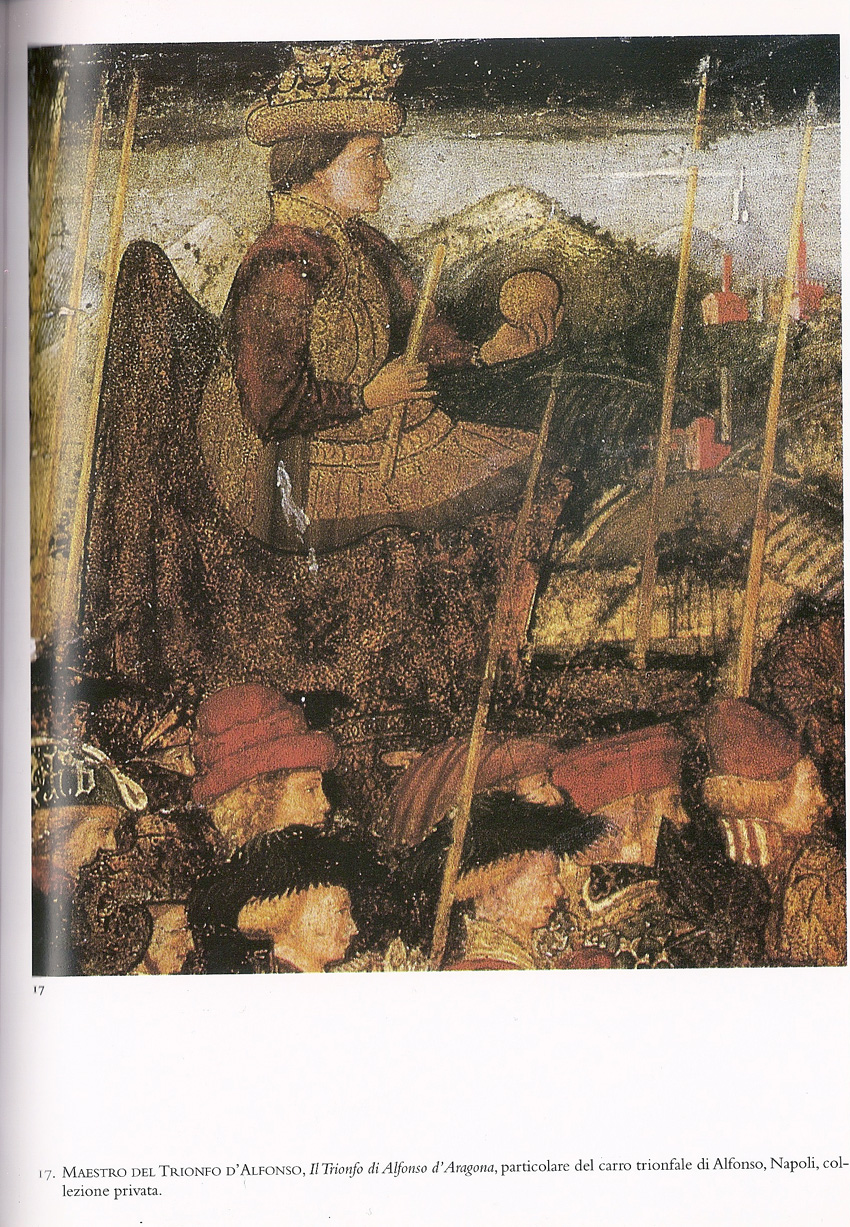
http://www.rosscaldwell.com/images/triu ... detail.jpg
which is a detail of this cassone, a chest, from 1452 (please excuse the crease, my book was screaming for mercy):

http://www.rosscaldwell.com/images/triu ... assone.jpg
For Borso, I only have this b/w image - I have seen it in color, but I forget where now:
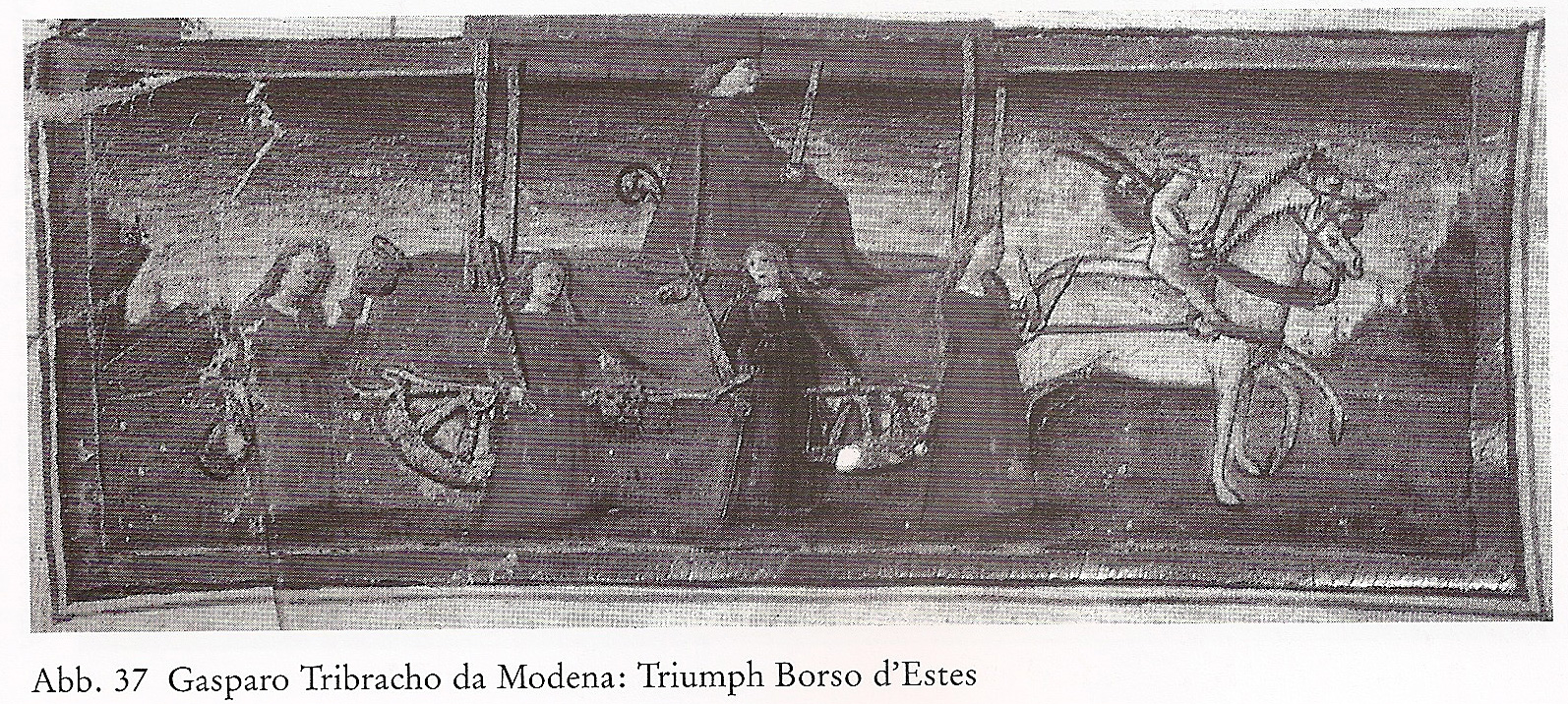
http://www.rosscaldwell.com/images/triu ... riumph.jpg
I think the cap is red.
Using this style of cap to represent a triumphator would be similar to how artists used the headgear of John Palaiologos to represent not only him, but "eastern" or "exotic" kings, after his visit to the council in 1438-1439. It is a truism of iconology now.
I have shown, and can show as much as you like, that the winged helmet is not an indicator of lateness. I don't know that plumed horses are "trans-alpine" either, but this is an interesting point. It is - or seems to be, in my looking for cognates - a rare feature, and unique to the Bolognese tarot, which has preserved it from the Rothschild sheet until today. The Bolognese packs never lose it.
I can't say that the Rothschild image is conservative, since it is the earliest of the Bolognese cards. All I can say is that the Bolognese iconographical and ludic tradition is conservative (in this case, preserving this detail for 500 years), and this supports the conjecture that the Rothschild images reflect earlier Bolognese practice.
I'm very impressed by the plumed horses - I'll keep looking for contemporary cognates.
Ross

Re: The Chariot
4Hi Ross,
You do not believe that there is a relationship between the wings of the helmet and the Plato's winged chariot mith? in turn, and returning to the anonymous image of paris, geese or swans that are pulling the cart could not make connection to the myth?
Saludos!
You do not believe that there is a relationship between the wings of the helmet and the Plato's winged chariot mith? in turn, and returning to the anonymous image of paris, geese or swans that are pulling the cart could not make connection to the myth?
Saludos!
Re: The Chariot
5hi, Ross
... I still don't understand your thesis and also not your arguments.
At the Alfonso cassone picture (the total picture) is a Julius Caesar, as he is described for the real Trionfo of Alfonso 1443, standing on a globe (on the picture and in the description). His figure has no helmet, no wings. Do we see the same?
... I still don't understand your thesis and also not your arguments.
At the Alfonso cassone picture (the total picture) is a Julius Caesar, as he is described for the real Trionfo of Alfonso 1443, standing on a globe (on the picture and in the description). His figure has no helmet, no wings. Do we see the same?
Huck
http://trionfi.com
http://trionfi.com
Re: The Chariot
6Hi lamort,
I don't know how to interpret the scene in the Anonymous Parisian Chariot, but at least here, the triumphator is wearing a wreath and not a winged helmet. Swans generally represent Venus, so maybe it says he is being driven - or rather dragged along - by love.
Right - I don't think there is a relation in the Bolognese Chariot to this story. My belief is that he is an archetypal Roman triumphator.lamort wrote:Hi Ross,
You do not believe that there is a relationship between the wings of the helmet and the Plato's winged chariot mith? in turn, and returning to the anonymous image of paris, geese or swans that are pulling the cart could not make connection to the myth?
I don't know how to interpret the scene in the Anonymous Parisian Chariot, but at least here, the triumphator is wearing a wreath and not a winged helmet. Swans generally represent Venus, so maybe it says he is being driven - or rather dragged along - by love.

Re: The Chariot
7Huck wrote:hi, Ross
... I still don't understand your thesis and also not your arguments.
At the Alfonso cassone picture (the total picture) is a Julius Caesar, as he is described for the real Trionfo of Alfonso 1443, standing on a globe (on the picture and in the description). His figure has no helmet, no wings. Do we see the same?
Yes, this one -

http://www.rosscaldwell.com/images/triu ... caesar.jpg
here his helmet is between his feet.
It's not Caesar's triumph that is being depicted here - he is there to warn Alfonso (and later Borso) not to trust Fortune, noting his own example, and not to become a tyrant (it was the Florentines who were responsible for the staging of this particular part of the pageant, and they normally regarded Caesar as a tyrant, albeit a glorious one).
For Borso, the same poem, adapted by Malatesta Ariosti, the ideology is different - Borso IS a tyrant (in the best sense), and he threatens no one, so Caesar only says "may you keep your realm in liberty".

Re: The Chariot
8The value of Caesar's appearance in Alfonso's (and Borso's) triumph for me is what he says (Caesar addressing the prince) -Huck wrote:hi, Ross
... I still don't understand your thesis and also not your arguments.
At the Alfonso cassone picture (the total picture) is a Julius Caesar, as he is described for the real Trionfo of Alfonso 1443, standing on a globe (on the picture and in the description). His figure has no helmet, no wings. Do we see the same?
"King on high, O New Caesar,
Justice, with Fortitude and Temperance,
Prudence, Faith, Charity and Hope,
Will make you triumph in every battle.
If these rulers you will take in your home,
That chair would be made for your (permanent) place;
But, take note, you will be without,
If from Justice you wrest the seal.
But Chance, who offers her locks to you,
do not trust in everything, for she is false,
who put me, who triumphed, in decline.
Behold the changeable world!
It is volatile, hold this as your destiny:
As God would have it, because it pleases him.
Alfonso, King of Peace,
May God exalt and prosper you,
Preserving my Florence in liberty."
Eccelso Re, o Cesare novello,
Giustizia con Fortezza e Temperanza,
Prudentia, Fede, Carità e Speranza,
ti farà trionfar sopr’ogni bello.
Se queste donne terrai in tu’ostello,
quella sedia fia fatta per tua stanza;
ma, ricordasi a te, tu sarai sanza,
se di Giustizia torcessi ‘l suggello.
E la Ventura, che ti porge il crino,
no ti dar tutto a lei, ch’ell’è fallace,
che me, che trionfai, misse in dechino.
El mondo vedi che mutazion face!
Che sia voltabil, tienlo per destino:
e questo vuole Iddio perché li piace.
Alfonso, Re di pace,
Iddio t’esalti e dia prosperitate,
salvando al mio Firenze libertate.
In Borso's version, he says a little different:
Excelso principe, o duca nouello,
Justicia cum forteza, temperantia
Prudentia, fede, Carita et speranza
Te faranno triumphare supra ogne bello.
Se queste Donne tu tera in tuo stillo
Questa sedia hanno facta per tua stantia
Ricordati che farai senza
Se ala Justicia torgiesse el sugello.
Et la fortuna che te porgie el creno
Non te fidare in ley, che la e falaze
Che mi che triumphai, messo in declino.
Voltabile et tolo per destino
Tu vedi il mondo che mutazione faze.
Et questo vole Jdio perche le piazze.
Borso Ducha di paze
Christo te exalta in tua prosperitade
Questo tuo Regio tu mantegni in libertade.

Re: The Chariot
9I wouldn't see it as a helmet, if you wouldn't have told me ... also I wouldn't see a winged helmet.
But, agreed, it's a possibility.
The description (in German from a shortened translation of an observer's observation, ? Francesco Laurano ?) tells of a laurel crowned Caesar, no helmet. It also tells of a genius (showing the passing luck) at the feet of a Fortuna (I assume, that Fortuna = this Occasio-like figure), which also is missing on the picture. A Fama is there, but missing in the description. A tower with a door-guarding angel and 4 virtues at the top it, singing ... is in the description and missing on the picture, which has instead two angels circling at a mountain.

This is another show of the same activity )quite different in his representation) and it took 12-13 years to be finished - 1452/53 - 1464. As it's start is similar to the date of your painting (which is really a nice finding), it has to be assumed, that around 1452 various designs were attempted to have a choice, which model would have been made finally "in stone" and "forever".
In time this situation followed the Emperor visit (+ marriage) in spring 1452 ... Alfonso had managed the negotiations and got special honor for it.
Probably the emperor got a Trionfi deck (and a column in stone) in Siena and Alfonso got ideas, that he should do something about his own triumph. A porta triumphalis with Trionfi picture surely was something greater than a humble wedding column in Siena, everybody would see that ... vanity says ... .
.
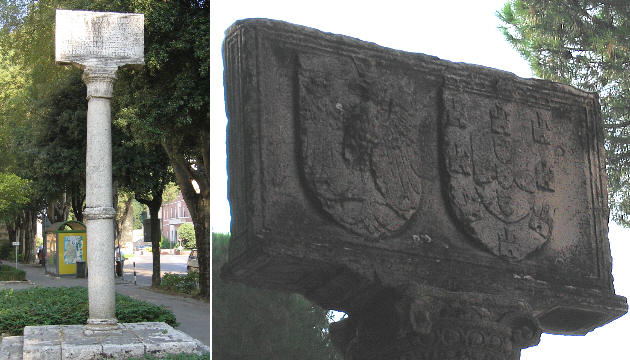

The Trionfi shows differed creatively in their appearance, even one concrete real show (that of 1443 Naples) could have variants in the "memory process" ... so did the connected decks (my conclusion in contrast to the standard-deck-theory).
This is a Ferrante Trionfo, given to 1460 to 1470
http://commons.wikimedia.org/wiki/File: ... 4_f_1v.jpg
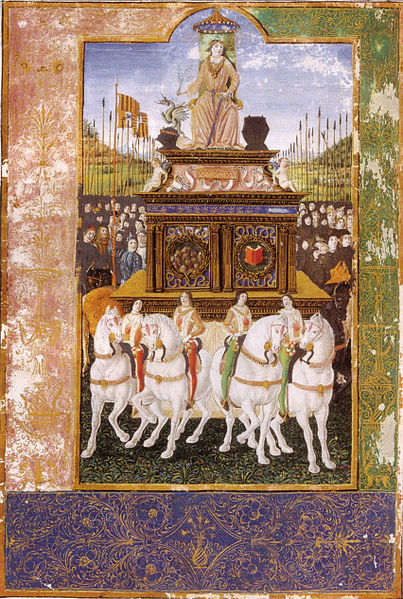
In the left bottom corner of the following detail we see a helmet. It looks "without wings" (but with "winged dragon") like a twin of the object at the feets of Caesar in the Cassone picture.

A helmet with winged dragon appears at this Sforza picture (De Sfera manuscript ca. 1470)...
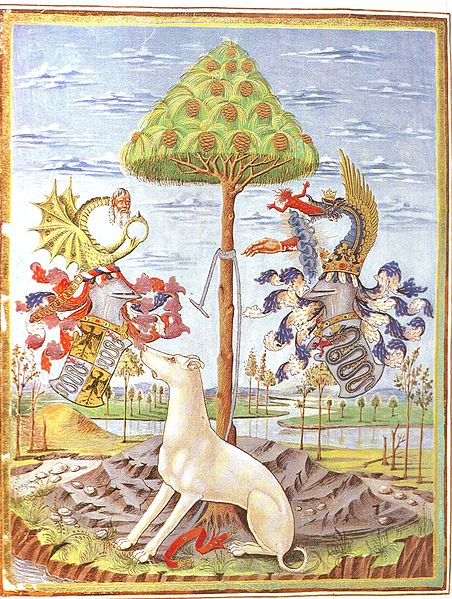
In this case the left "winged dragon" with man face holds a diamond ring ...
... the Hymeneus of the marriage Camilla of Aragon and Constanzo Sforza had such a diamond ring ...

.. so this looks like a wedding. ... ?????
But I learn the following from Wikipedia:

... or a dragon

....
the book, said to have been made ca. 1470 went with Anna Sforza (daughter of Bona of Savoy/Galeazzo Maria) to Ferrara with her marriage to Alfonso d'Este 1491.
... ... all these heraldic ideas are a little bit confusing, aren't they?
... all these heraldic ideas are a little bit confusing, aren't they?
*********
Desperation and joke aside, no, I don't think, that this Caesar of the Cassone has a "winged helmet" at his feet (this optic is not good enough for that conclusion), but a helmet might be right.
Although ...
"Behold the changeable world!
It is volatile, hold this as your destiny:
As God would have it, because it pleases him."
"El mondo vedi che mutazion face!
Che sia voltabil, tienlo per destino:
e questo vuole Iddio perché li piace."
or
"Voltabile et tolo per destino
Tu vedi il mondo che mutazione faze.
Et questo vole Jdio perche le piazze."
... lets me think of a "world-globe with wings" and Caesar stands on a world globe, and that idea leads (for me) to Alberti's logo "Quid tum" ... which, as I've read, is from the ECLOGUES of Vergil and translated belongs to this passage ...
... so it means "WHAT IF ..." . The whole text goes in direction to Arcadia and Shephard literature and has a lot of homoerotic associations. As Alberti died 1472 and Sannazoro wrote his Arcadia in his youth in the 1480's, one can understand, that Alberti was "very modern" in his time.
The other side of the coin showed not a "flying world", but a "flying eye" and both should look similar ... or should have a similar association.

But, agreed, it's a possibility.
The description (in German from a shortened translation of an observer's observation, ? Francesco Laurano ?) tells of a laurel crowned Caesar, no helmet. It also tells of a genius (showing the passing luck) at the feet of a Fortuna (I assume, that Fortuna = this Occasio-like figure), which also is missing on the picture. A Fama is there, but missing in the description. A tower with a door-guarding angel and 4 virtues at the top it, singing ... is in the description and missing on the picture, which has instead two angels circling at a mountain.

This is another show of the same activity )quite different in his representation) and it took 12-13 years to be finished - 1452/53 - 1464. As it's start is similar to the date of your painting (which is really a nice finding), it has to be assumed, that around 1452 various designs were attempted to have a choice, which model would have been made finally "in stone" and "forever".
In time this situation followed the Emperor visit (+ marriage) in spring 1452 ... Alfonso had managed the negotiations and got special honor for it.
Probably the emperor got a Trionfi deck (and a column in stone) in Siena and Alfonso got ideas, that he should do something about his own triumph. A porta triumphalis with Trionfi picture surely was something greater than a humble wedding column in Siena, everybody would see that ... vanity says ...


The Trionfi shows differed creatively in their appearance, even one concrete real show (that of 1443 Naples) could have variants in the "memory process" ... so did the connected decks (my conclusion in contrast to the standard-deck-theory).
This is a Ferrante Trionfo, given to 1460 to 1470
http://commons.wikimedia.org/wiki/File: ... 4_f_1v.jpg

In the left bottom corner of the following detail we see a helmet. It looks "without wings" (but with "winged dragon") like a twin of the object at the feets of Caesar in the Cassone picture.

A helmet with winged dragon appears at this Sforza picture (De Sfera manuscript ca. 1470)...

In this case the left "winged dragon" with man face holds a diamond ring ...
... the Hymeneus of the marriage Camilla of Aragon and Constanzo Sforza had such a diamond ring ...

.. so this looks like a wedding. ... ?????
But I learn the following from Wikipedia:
... damn, this dragon with wings and man's face looks like a bat.The heraldic use of the bat in Valencia, Catalonia and the Balearic Islands has its origins in a winged dragon (vibra or vibria) that was crowning the helmet or cimera reial of the Kings of Aragon. Although traditionally the dragon helmet is ascribed to king James I of Aragon (1208 – 1276),[1] reliable documents state that the winged dragon cimera reial didn't appear over the helmet until Peter IV of Aragon's reign (1319 – 1387).
There is also a legend that says that thanks to the humble intervention of a bat, king James I of Aragon was able to win a crucial battle against the Saracens that allowed him to win Valencia for his kingdom. However, original documents state that the animal was a swallow and not a bat.

... or a dragon

....
the book, said to have been made ca. 1470 went with Anna Sforza (daughter of Bona of Savoy/Galeazzo Maria) to Ferrara with her marriage to Alfonso d'Este 1491.
...
*********
Desperation and joke aside, no, I don't think, that this Caesar of the Cassone has a "winged helmet" at his feet (this optic is not good enough for that conclusion), but a helmet might be right.
Although ...
"Behold the changeable world!
It is volatile, hold this as your destiny:
As God would have it, because it pleases him."
"El mondo vedi che mutazion face!
Che sia voltabil, tienlo per destino:
e questo vuole Iddio perché li piace."
or
"Voltabile et tolo per destino
Tu vedi il mondo che mutazione faze.
Et questo vole Jdio perche le piazze."
... lets me think of a "world-globe with wings" and Caesar stands on a world globe, and that idea leads (for me) to Alberti's logo "Quid tum" ... which, as I've read, is from the ECLOGUES of Vergil and translated belongs to this passage ...
http://www.theoi.com/Text/VirgilEclogues.htmlBut sadly Gallus replied: “Yet you, Arcadians, will sing this tail to your mountains; Arcadians only know how to sing. How softly then would my bones repose, if in other days your pipes should tell my love! And oh that I had been one of you, the shepherd of a flock of yours, or the dresser of your ripened grapes! Surely, my darling, whether it were Phyllis or Amyntas, or whoever it were – and what if Amyntas be dark? violets, too, are black and black are hyacinths – my darling would be lying at my side among the willows, and under the creeping vine above – Phyllis plucking me flowers for a garland, Amyntas singing me songs. Here are cold springs, Lycoris, here soft meadows, here woodland; here with you, only the passage of time would wear me away. But now a mad passion for the stern god of war keeps me in arms, amid clashing steel and fronting foes; while you, far from your native soil – O that I could but disbelieve such a tale! – gaze, heartless one, on Alpine snows and the frozen Rhine, apart from me, all alone. Ah, may the frosts not harm you! Ah, may the jagged ice not cut your tender feet!
... so it means "WHAT IF ..." . The whole text goes in direction to Arcadia and Shephard literature and has a lot of homoerotic associations. As Alberti died 1472 and Sannazoro wrote his Arcadia in his youth in the 1480's, one can understand, that Alberti was "very modern" in his time.
The other side of the coin showed not a "flying world", but a "flying eye" and both should look similar ... or should have a similar association.

Huck
http://trionfi.com
http://trionfi.com
Re: The Chariot
10Hi Huck,
I gave examples of winged helmets on Caesar in this post
viewtopic.php?f=12&t=334&start=10#p4294
in the Bologna thread. I have others.
This thread is about the iconography of the Chariot, which was the point of my post - to show where the cap of the triumphator in early A-style cards - Charles VI, Catania (Castello Ursino), Rosenwald - might have come from.
I suggest if you want to talk about my theory, we move it to the Bologna thread.
I never suggested that this was a winged helmet.Huck wrote:I wouldn't see it as a helmet, if you wouldn't have told me ... also I wouldn't see a winged helmet.
I gave examples of winged helmets on Caesar in this post
viewtopic.php?f=12&t=334&start=10#p4294
in the Bologna thread. I have others.
This thread is about the iconography of the Chariot, which was the point of my post - to show where the cap of the triumphator in early A-style cards - Charles VI, Catania (Castello Ursino), Rosenwald - might have come from.
I suggest if you want to talk about my theory, we move it to the Bologna thread.



